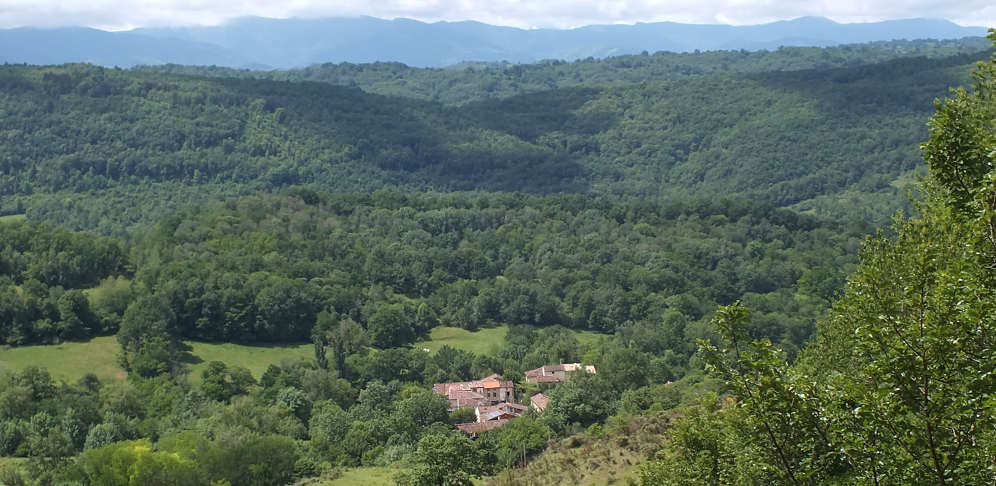
The Best of Rural France
Areas off the beaten track, but with plenty to do
- Explore France ►
- Key pages
- Where to go
- How to get there
- More about France
About-France.com
- the connoisseur's guide to France
Far away from the crowds - rural France at its best
Most of France is "rural", in the sense of land that is lightly (not sparsely) inhabited, areas characterised by their small towns and villages and by agriculture. In a word, most of France is countryside.
Holidaymakers looking for somewhere to chill out and relax in the peace and quiet of rural France thus have a huge and very varied area to choose from. Those for whom the main aim of a rural break is to relax in the shade of a tree or beside a pool, and do nothing for a week or two, have virtually the whole of France to choose from. Those wanting a bit more than that, i.e. to have a quiet rural base from which to explore interesting countryside, interesting walks and wildlife, or interesting heritage or attractions nearby, need to be a bit more choosy.
There are plenty of parts of rural France that are very peaceful but not terribly interesting. There are lots of villages in France that are very attractive in their own right, but surrounded in all directions by little else but fields.
Generally speaking, the French countryside - as indeed countryside anywhere - is more interesting in hillier parts. This is all the more so in France insofar as the hillier parts are also the areas where the historic rural heritage has survived most strongly. Generally speaking, and with some exceptions, notably rural Brittany, this means France south of the Loire.
With this in mind, About-France.com brings you a pick of eight of the best rural departments (counties) in France, departments that are deeply rural and far from the crowds, yet offer interesting countryside with plenty of opportunity for rural pursuits, and plenty of interesting sites and sights to visit
Eight unspoilt rural departments in France
| Jump straight to a department | |||
| 22 Côtes d'Armor | 53 Mayenne | 36 Indre | 39 Jura |
| 19 Corrèze | 43 Haute Loire | 12 Aveyron | 09 Ariège |
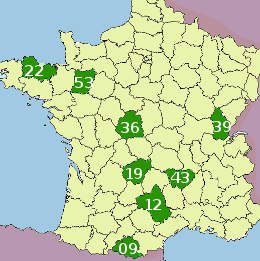 Listed alphabetically,
here is a pick of eight of the best French
departments in which to enjoy a rural break, away from the stresses and
strains of city life. These eight departments are all very rural, have
plenty of interesting things to see and do, but do not have a lot in
the way of major tourism development (except, in the case of Côtes
d'Armor, 22, on the coast).
Listed alphabetically,
here is a pick of eight of the best French
departments in which to enjoy a rural break, away from the stresses and
strains of city life. These eight departments are all very rural, have
plenty of interesting things to see and do, but do not have a lot in
the way of major tourism development (except, in the case of Côtes
d'Armor, 22, on the coast). Some of these departments (Ariège - 09, Haute Loire - 43, and Mayenne - 53 ) are among the ten least visited departments in France, which, given what they have to offer, is surprising. These are the best hidden gems. Only two of the eight departments selected, Aveyron - 12 (partly on account of its size) and Côtes d'Armor (where the coast is popular) received slightly over half a million tourists in 2024... compared to over 2 million visitors each, sometimes well over, for the ten most touristic departments of France, and over 15 million for Paris.
The list deliberately excludes the most popular rural departments, like the Dordogne or the Charentes, which are well-known and have a thriving rural tourism industry.
-
Ariège (09)
 Midi-Pyrenees
area.
Ariège is the sole essentially Pyrenean department
that does not have the word Pyrenees in its name. It is also one of the
five least visited departments in France! Lying to the south
of
Toulouse,
Ariège is deeply rural, with a landscape that reaches from
the plains
of the Garonne to the peaks of the Pyrenees. The departmental capital
Foix is
the smallest departmental capital city in France, with less
than 10,000 inhabitants.
Midi-Pyrenees
area.
Ariège is the sole essentially Pyrenean department
that does not have the word Pyrenees in its name. It is also one of the
five least visited departments in France! Lying to the south
of
Toulouse,
Ariège is deeply rural, with a landscape that reaches from
the plains
of the Garonne to the peaks of the Pyrenees. The departmental capital
Foix is
the smallest departmental capital city in France, with less
than 10,000 inhabitants.
The area is characterised by wooded hills and farmland, with lots of small towns and villages, including some attractive hill towns.
Among the attractions of Ariège are Foix, with its impressive castle, and a number of interesting visitable prehistoric sites. Ariège is also home to some of the more inland of the medieval Cathar castles. The area is very popular for hiking and, in the south of the department, mountaineering on the high peaks of the Pyrenees. Popular excursions from the Ariège include day trips to visit the walled city of Carcassonne (very touristy), or into neighbouring Andorra (also very touristy) or over the border into the Spanish Pyrenees (less touristy). The countryside on the southern side of the Pyrenees - arid and rocky - is very different from the green countryside of Ariège.
Access. Fly to Toulouse or Carcassonne. Drive down via Orleans and Toulouse (A20) or Orleans and Clermont Ferrand (A71). Train. TGV From Paris gare Montparnasse to Toulouse, then local service to Foix.
Accommodation : Explore a big choice of places to stay in Ariège from Booking.com -
Aveyron (12)
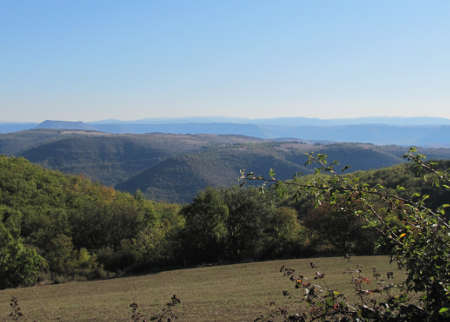 Midi-Pyrenees
area. One of the largest and
reputedly the
"greenest" department of France, Aveyron is characterised by a
significant range of different types of countryside.
In the
north, the Aubrac plateau, at over 1000m, is the southern bastion of
the high Massif Central.
In the east, Aveyron includes parts of the
Causses uplands, dry limestone hills through which flow deep
river valleys or gorges. In the centre and south, Aveyron is undulating
hill country, famed for its sheep farming. In the west, the lowest part
of the department, there are hills and valleys and the start of the
oak-forested Quercy region that continues into the neighbouring
department of the Lot.
Midi-Pyrenees
area. One of the largest and
reputedly the
"greenest" department of France, Aveyron is characterised by a
significant range of different types of countryside.
In the
north, the Aubrac plateau, at over 1000m, is the southern bastion of
the high Massif Central.
In the east, Aveyron includes parts of the
Causses uplands, dry limestone hills through which flow deep
river valleys or gorges. In the centre and south, Aveyron is undulating
hill country, famed for its sheep farming. In the west, the lowest part
of the department, there are hills and valleys and the start of the
oak-forested Quercy region that continues into the neighbouring
department of the Lot.
The departmental capital, Rodez, has a historic centre with some fine Renaissance town houses and one of the biggest gothic cathedrals in southern France. It also has the recently built Soulages museum, housing a large collection of works by France's most famous living artist.
Aveyron is the department of France with the greatest number of villages listed as "most beautiful villages in France" ; and there are dozens more very pretty villages that are not listed. There are a lot of hiking trails in Aveyron, and among the major attractions in the department are the Millau Viaduct and the Tarn valley, Rodez, with its museums and medieval cathedral, and several bastide towns. Just outside Aveyron, other attractions include the Tarn Gorge, the Unesco listed historic city of Albi, and the pilgrimage site of Rocamadour.
Access Fly direct to Rodez, or to Toulouse. Access by road is via Orleans, Clermont Ferrand and the A75 for most of the department, or via Orleans Limoges and the A20 for the west. Train access is very slow. From Paris Gare d'Austerlitz, change at Brive la Gaillarde.
Accommodation : Explore a big choice of places to stay in Aveyron from Booking.com -
Corrèze (19)
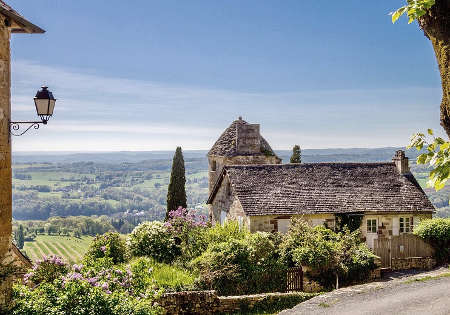 Limousin
area.
The most inland department of the former Limousin region is mostly
hilly and its countryside varies from gentle southwestern plateau, in
the west
of the department bordering the Dordogne
and the Lot, both popular
rural tourism departments, to high plateau in the east, bordering the
high part of the Auvergne
region.
Limousin
area.
The most inland department of the former Limousin region is mostly
hilly and its countryside varies from gentle southwestern plateau, in
the west
of the department bordering the Dordogne
and the Lot, both popular
rural tourism departments, to high plateau in the east, bordering the
high part of the Auvergne
region.
Corrèze is crossed from east to west by two significant valleys, the valley of the Corrèze in the middle, and the upper valley of the Dordogne in the south. Between them and to the north lie areas of hill country, characterised by mixed agriculture and lots of deciduous forest, mergeing to coniferous forest in the high-lying northeast of the department, which includes much of the Regional Park of the Plateau de Millevaches.
The largest town in the department, Brive la Gaillarde, lies in the Corrèze valley, and is an attractive small town, built in the local pale limestone, and with a.population of around 50,000. This is considerably more than the departmental capital, Tulle, further up the valley... which is nonetheless the third largest town in the former region of Limousin, after Limoges and Brive. Among the attractive small towns are Uzerches, and the town of Argentat on the Dordogne.
Other attractions in the Corrèze include the unique historic slate mines at les Pans de Travassac, the upper Dordogne valley with its reservoirs and water sports, and several impressive castles to visit.
Not far from the borders of Corrèze are the prehistoric sites and castles of the Dordogne department to the southwest, and the high peaks of the Auvergne, Sancy and Plomb du Cantal, to the east.
AccessFly direct to Brive, or to Limoges. Access by road is via Orleans, Limoges and the A20, or via the A89 which crosses the department from east to west. Access by train directly to Brive from Paris gare d'Austerlitz.
Accommodation : Explore a big choice of places to stay in Corrèze from Booking.com -
Côtes d'Armor (22)
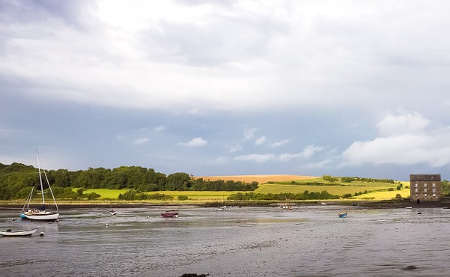 Brittany.
Brittany.
What is most surprising about the Côtes d'Armor department is that it gets less tourists than any other French coastal department other than les Landes, in SW France. But the coast of les Landes has few seaside towns, and much of it is hard to reach. This is not true of the Côtes d'Armor.
This department, covering the north central part of Brittany, has a very attractive coastline with cliffs and rocks, interspersed with small sandy coves, small coastal towns or villages, and attractive but generally small sandy beaches.
The capital of Côtes d'Armor is Saint Brieuc, which has a small historic centre and a rather austere medieval granite cathedral; but the most attractive and most visited small town in the department is Dinan, whose historic centre, surrounded by ramparts, sits atop a bluff overlooking the valley of the river Rance. Other attractive small towns in the department include Paimpol, with its quays and its historic church built on a rocky outcrop, and Moncontour, another hilltop town with a historic centre and some surviving ramparts.
However it is not for its small towns that Côtes d'Armor is best loved, but for its beautiful coastline and its peaceful countryside. The coast, known in the east as the Côte de Goëlo and in the west as the Côte de Granit Rose - the pink granite coast - is wild and rocky, with some dramatic landscapes as at Cap Fréhel and Fort La Latte. There are also a handful of small resorts, notably Erquy, Saint Quay-Portrieux and Perros Guirec.
Inland Côtes d'Armor is a slightly undulating countryside made up hedge-lined fields and small woods; in the many small villages and towns, the older buildings are all built in the local granite, rather like in Cornwall. In the south of the department, the lake and forest at Guerlédan is a popular rural attraction, appreciated by bathers, anglers and walkers.
The inland part of Côtes d'Armor is attractive for its peaceful countryside, but also for its central location within the Breton peninsula. From Rostrenen in the southwest of the department, it's just over an hour's drive to Paimpol on the north coast, to Crozon on the west coast, or Larmor plage on the south coast.
Places to visit within easy access of the Côtes d'Armor include the historic heritage city of Saint Malo, the port of Brest, and the megalithic site of Carnac.
Access Fly to Dinard, Brest or Nantes. Access by road from Calais via Rouen and Alençon, or from Caen, Cherbourg or Le Havre in under 4 hours. Access by train : Direct TGV from Paris Gare Montparnasse to Saint Brieuc in a bit over 3 hrs.
Accommodation : Explore a big choice of places to stay in Côtes d'Armor from Booking.com -
Haute Loire (43)
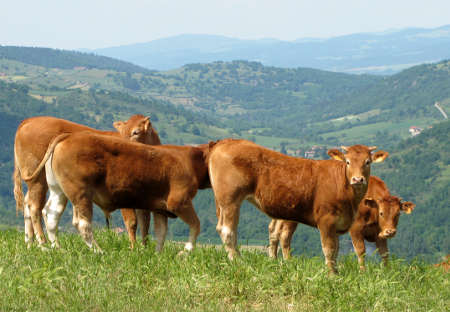 Auvergne area.
Auvergne area.
One of the ten least visited departments in France, the Haute Loire is the driest department of the Auvergne. It is characterised in particular by the high valleys of the rivers Loire and Allier. The very sunny upper Allier valley area still has some of the vineyards that made it famous in the past. It is the lowest part of the department. The upper part of the Loire runs from its source in the volcanic highlands south of the departmental capital Le Puy en Velay, and on through a long deep valley towards the northeast. Between the Loire and the Allier, the Monts du Forez are an area of high country at around 1000 metres altitude, mostly forest and grazing land, and similar, though not quite so high, as the Monts de la Margeride which form the western edge of the department. Around Le Puy is a high plateau, the Velay, which is a good agricultural area. Much of the Haute Loire is of volcanic origin.
Le Puy, the departmental capital, is like no other French city, with its Unesco-listed medieval churches built on rocky pinnacles. The attractive city is famous for its lace, and has a good small museum. Brioude, in the north of the department, close to the Allier, has a meridional air, and is one of the prettiest small towns in France. It boasts a superb medieval basilica (not Unesco listed, but a top three star ranking with Michelin), and a new Contemporary Arts centre, as well as an aquarium.
The Haute Loire has lots of attractive countryside and villages, impressive castles ,and - notably in the area around Brioude - lots of early medieval churches with frescoes. Both the Loire and the Allier are good rivers for fishing and family kayaking, and the department has an impressive network of hiking and mountain-biking trails.
Attractions close to the Haute Loire include the high peaks of the Auvergne, Sancy and the Massif du Cantal, and the Vulcania theme park near Clermont Ferrand
Access. Fly to Clermont Ferrand or Lyon. Access by road is via Orleans, and Clermont Ferrand. Access by train via Clermont Ferrand for the north of the department, via Lyon and Saint Etienne for the south.
Accommodation : Explore a big choice of places to stay in the Haute-Loire from Booking.com -
Indre (36)
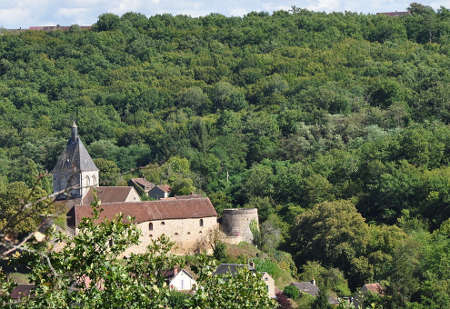 Centre-Val-de-Loire
region
Centre-Val-de-Loire
region
The department of the Indre lies just to the west of the geographic centre of France. It covers an area stretching from fairly flat land at the southern edge of the Loire basin, to the first foothills of the Massif Central in the southeast.
It is the least visited department in the Loire valley regions, and is particularly remarkable for the fact that over 20% of the department is classed as a regional park, the Parc Naturel Régional de la Brenne, which, with its over 2700 lakes, is one of Europe's major freshwater wetlands with many nature reserves. The department is largely agricultural, with cereals and mixed agriculture, but more wooded in the Brenne area. It is crossed by the meandering valleys of the rivers Creuse and Indre.
The departmental capital is the city of Chateauroux, population 44,000, a city with no significant monuments to attract tourists, and one of only two towns in the department with more than 5000 inhabitants. Indre's strong points lie elsewhere, in its natural environment, in its villages, and in its numerous historic monuments.
Most impressive of these is the château at Valençay, built mainly in the 15th and 16th centuries, one of the most imposing of the great Loire valley châteaux. Another magnificent château is Azay-le-Ferron, a 15th-18th century chateay in the Brenne area. Near La Chatre in the south of the department, the château de Sarzay is an impressive medieval fortress that was later converted into a residence.
The Indre department is forever attached to the memory of George Sand, real name Aurore Dupin, the most famous and infamous French female novellist of the 19th century whose aristocratic family seat was at Nohant. Sand spent much time there, notably with her lover Frédéric Chopin. The legacy of Sand and Chopin remains in the family château at Nohant, and the very pretty village of Gargilesse with its castle, 12th century church, and the house where Sand once lived. Just south of Gargilesse, behind a dam on the river Creuse, the Lac d'Eguzon is a popular location for water sports.
Interesting places that are easily accessible from the Indre area include to the north the Loire valley châteaux, to the northeast the historic city of Bourges, with its great medieval cathedral,, and to the southwest the historic city of Poitiers and the Futuroscope theme park.
Accommodation : Explore a big choice of places to stay in Indre from Booking.com -
Jura (39)
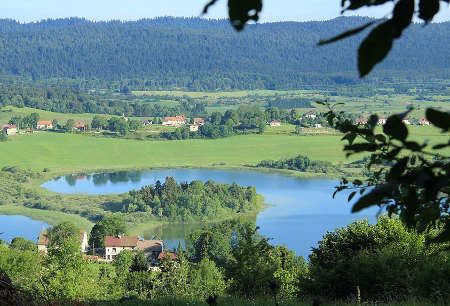 Franche-Comté
area.
Franche-Comté
area.
the Jura is one of the most beautiful parts of eastern France. The name of the department refers to the mountain range that runs along the Swiss border between the Rhone valley in the south and the Rhine valley in the north east.
The Jura department occupies the southern end of this ancient mountain range, from which the Jurassic period in Earth's history takes its name. Half of the department is upland country, culminating in the highest peaks along the Swiss border which reach up to 1500 metres. The mountain area of the Jura is made up of a series of plateaux, through which several rivers have carved deep valleys. The Jura mountains are famous for cheese, in particular Comté and local Gruyère; they offer landscapes of large areas of pastures, often echoing to the sound of cow-bells, between forests of giant conifers. In winter, the higher parts of the Jura are known for their nordic skiing areas; in summer, this is a part of France that always remains refreshingly green, however hot it gets.
The departmental capital Lons le Saunier is one of the smaller capitals in France, with just over 17,000 inhabitants. It's an delightful small city, with attractive old arcades along the main shopping street, but no other great claim to fame. Lons stands between the hills to the east, and the plain to the west. And between hills and plain there is also the Jura wine producing area, between Lons and the local wine capital Arbois.
Among the places of interest in the Jura are the High Jura regional park - great for hiking, and the lakes of Chalain and Vouglans. Interesting cities include Morez and Saint Claude, one famous for its pipes, the other as the glasses capital of France, both of which lie at the bottom of deep valleys. The wine producing centre of Arbois is also a very pretty small town, and it is here that Pasteur discovered the process of known worldwide as pasteurisation. Finally, towards the north of the department is the small city of Dole, on the banks of the river Doubs.
Within easy access of the Jura are the historic cities of Dijon and Besançon, and from the High Jura it is easy to nip over the border into Switzerland, and even to make a day trip to Lake Geneva or Geneva itself.
Access Fly to Lyon or Geneva. Access by road from Calais or northern France is via the A26 motorway to Reims and Dijon Access by train TGV from Paris Gare de Lyon to Dole, then local trains.
Accommodation : Explore a big choice of places to stay in the Jura from Booking.com -
Mayenne (53)
 Pays de la Loire region
Pays de la Loire region
The department of Mayenne is one of the ten least visited departments in France, and the least visited department in western France, making it an excellent area to escape not just from the crowds, but from the tourists too.
At the far north of the Pays de la Loire region, bordering on Brittany and on Normandy, it is well away from the main tourist areas of the Loire valley; and although the northeast corner of Mayenne is less than 40 km from the Normandy coast, few visitors planning a stay in rural Normandy look as far as Mayenne, as it is not part of Normandy.
Most of the department is undulating farmland, with arable and dairy farming; but the north of Mayenne also has the highest point in northwestern France, the Mont des Avaloirs, a forested upland at the eastern end of the Monts d'Armorique, which form the backbone of Brittany. The Mont des Avaloirs is capped by an observation tower from the top of which on a clear day the views stretch for over 100 km in all directions.
The department is crossed from north to south by the river Mayenne, which runs through the three main towns, Mayenne, the departmental capital Laval, and Chateau Gontier. The river is open for pleasure cruisers and boating all through the department to the south of the town of Mayenne, and the towpaths are popular with hikers and cyclists. Of the three towns along the river, the one that does not have a historic castle overlooking the river is - curiously - Château Gontier.
Laval, population just over 50,000, is an attractive small city with a big medieval castle overlooking the river, a gothic cathedral, and the Notre Dame basilica, with a fine romanesque apse. The streets of the old town have a number of fine Renaissance houses.
In the small town of Mayenne, the castle overlooking the river is one of the oldest in France. Though considerably rebuilt over time, the earliest parts of it go back to the age of Charlemagne (9th century).
Among other castles in the area that are worth visiting are notably the château at Craon, a fine 18th century stately home, and the three castles in the very attractive village of Lassay les Châteaux. Other interesting sites in the department include the Grottes de Saulgues prehistoric site and museum, with cave visits, the village of Sainte Suzanne, built on a rocky bluff overlooking the valley of the Erve, and the Arche animal refuge near Chateau Gontier, not a zoo, but a refuge for about 1000 animals - including lions and tigers - saved from ill treatment, seized by customs, or brought in after accidents.
Within easy reach of the Mayenne are notably the Mont Saint Michel and the castle of Fougères to the northwest, Le Mans to the east, and the city of Angers to the south.
Access Fly to Dinard, Rennes or Nantes. Access by road from Calais via Rouen and Alençon, or from Caen, Cherbourg or Le Havre in under 3 hours. Access by train Direct TGV from Paris Gare Montparnasse to Laval in under 1h30.
Accommodation : Explore a big choice of places to stay in Mayenne from Booking.com.
About-France.com
Home
page - Site search
- Regions
- Maps of France
While
the cities and coasts of France are the parts that attract the most
tourists and visitors, they are only a small part of the country. Above
all, France is rural, rather than urban or coastal. Compared to the UK,
France has about the same population, but its population is spread over
an area twice the size. In addition, only a small part of France is
wilderness (just a few high mountain areas), unlike the UK where large
areas of Scotland, Wales and northern England are largely uninhabited.
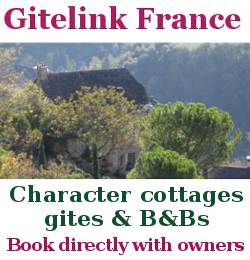

You might also like....

Hiking trail in the Aveyron
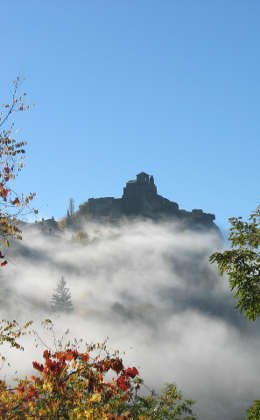
The French countryside can be splendid in the autumn - Haute Loire
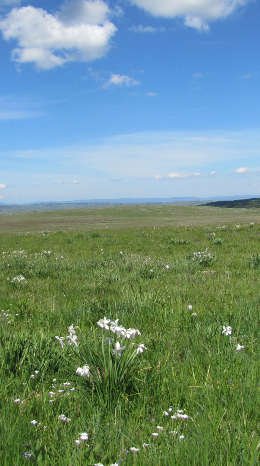
Upland country... great for hiking, great for views, but often lacking in other points of interest.
Copyright texts and photos © About-France.com 2003 - 2025 except;
Corrèze by Bonne Journée photography
Côtes d'Armor by Philmouss
Indre by Jean Faucheux, licenced Creative commons
Jura by RC75.
Mayenne by Montderve


You might also like....

Hiking trail in the Aveyron
More on rural France ...
- The regions of France - regional guides
- Wild France - mountain areas, uplands and other sparsely inhabited areas
- Small towns in France - Interesting small towns with character
- Beautiful unspoilt villages in France -
- Fly to France - who flies where to provincial airports throughout France

The French countryside can be splendid in the autumn - Haute Loire
An
independent website, About-France.com is an affiliate partner of
certain travel service websites,
and may receive a small commission on sales generated after users click
through to a partner site.
Click here for
low-cost car hire in France
low-cost car hire in France

Upland country... great for hiking, great for views, but often lacking in other points of interest.
Copyright texts and photos © About-France.com 2003 - 2025 except;
Corrèze by Bonne Journée photography
Côtes d'Armor by Philmouss
Indre by Jean Faucheux, licenced Creative commons
Jura by RC75.
Mayenne by Montderve

